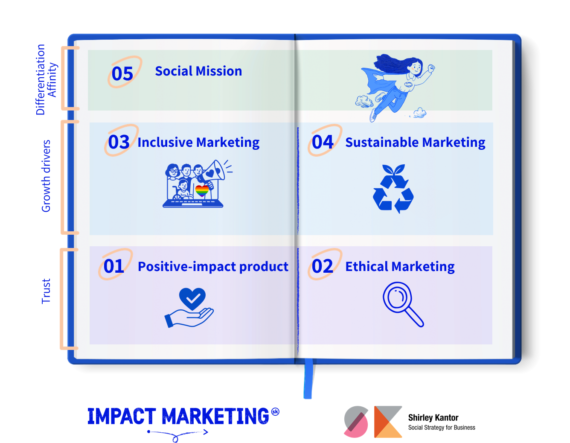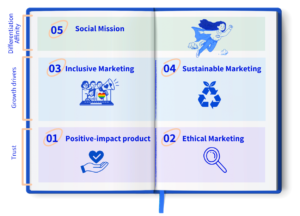Impact Marketing: A Strategy for Meaningful Growth in Uncertain Times
, עם 0 תגובות, קטגוריה: English Posts,The Impact Marketing strategy enables brands to thrive even in turbulent times by building stronger, more meaningful relationships with consumers and society, while gaining a competitive edge. In a world of growing uncertainty, the brands that truly stand out are those that offer genuine solutions and create positive value for both people and society.
=============
Uncertainty Is the New Normal - for People and for Brands
We live in an era defined by deep uncertainty. The cost of living is rising. AI is transforming the job market. Social polarization is growing. Trust in institutions is eroding. The climate crisis affects daily life, and war fuels chronic anxiety.
These realities are reshaping what people value and how they make purchasing decisions.
At the same time, the marketing landscape has undergone significant changes. Markets are saturated. Brand loyalty is eroding. Even purpose-driven campaigns face growing skepticism and are increasingly accused of greenwashing. Social media and AI have redefined authenticity and amplified public scrutiny.
So what do consumers want?
They want solutions. Not just “purposeful” brands or emotional storytelling, but products and services that genuinely improve their lives - physically, emotionally, or financially.
According to the 2025 Edelman Trust Barometer Special Report, 68% of people say it’s important that brands help them feel happy, confident, inspired, safe, and calm. And 61% say it’s important that brands help them contribute to positive change in the world.
Today’s consumers expect brands to deliver both personal benefit and social value, and they’re acting accordingly:
The 2025 Sustainability Perceptions Index reveals that claims related to environmental or social responsibility now account for 4% to 23% of purchase drivers across a wide range of categories, including food and consumer goods, electronics, hospitality, automotive, and even B2B and IT services.
A five-year study by McKinsey & NielsenIQ (2018–2022), analyzing 600,000 consumer products, found that items with claims related to environmental or social responsibility grew by 28%, compared to 20% growth for those without such claims.
While market conditions have since evolved, the findings suggest that, especially in highly competitive consumer categories, value-driven positioning can support growth when executed with credibility and relevance.
That’s the opportunity - and the challenge.
From Purpose to Growth: Making the Brand a Force for Good
To help brands meet these expectations and unlock the full potential of combining sustainability with marketing, I developed Impact Marketing:
A strategic marketing approach that systematically integrates social and environmental impact into every part of the marketing system - from product and packaging, to pricing, campaigns, storytelling, and customer experience.
This approach enables brands to create meaningful value for people, society, and the planet, while expanding their market, strengthening trust, deepening emotional connection, and gaining a competitive edge.
It also connects marketers to a new kind of mission: to become agents of change and creators of hope.
This is not philanthropy in disguise – it's a business growth strategy built on relevance, responsibility, and real-world value.
To implement this approach, the framework includes five core components:
(1) Positive-impact products; (2) Ethical marketing; (3) Inclusive marketing; (4) Sustainable ("green") marketing; (5) Social mission.
In addition to the five components, two foundational enablers are key to success:
-
Social Radar: Active listening to the concerns, needs, aspirations, and pain points of consumers, employees, and communities. This enables brands to identify genuine opportunities and avoid costly missteps.
-
Innovation: Applying technology and creativity to develop solutions to unmet social and environmental needs—fueling both purpose and growth.
The five core components of Impact Marketing
1. Positive-Impact Products
Designing products and services that are safe, healthy, and genuinely beneficial—solving real problems, supporting physical and mental wellbeing, saving time and money, or meeting previously unmet needs.
If adverse impacts are unavoidable, brands should minimize them and communicate them transparently, enabling informed choices.
The business benefit: increased trust, category differentiation, and access to new markets.
Example:
AXA, the global insurer, introduced a policy in France that covers housing for women escaping domestic violence, addressing a critical need and building brand trust.
Telekom launched a long-term campaign against online hate speech, offering educational tools and support to affected users, directly linked to how people use their digital services.
2. Ethical Marketing
This includes responsible messaging (especially with vulnerable audiences, such as children or older adults), avoiding manipulation, misinformation, or glorification of violence; ethical practices in influencer partnerships; and transparent, non-manipulative use of data and AI in marketing.
In many cases, regulation lags behind practice, so brands must go beyond compliance.
The business benefit: reduced risk, more substantial brand equity, and increased customer loyalty.
Example:
Dove has updated its ethical advertising policy to explicitly reject the use of AI-generated images of women in its campaigns. This strengthens its position as a brand that leads a consistent social agenda and builds long-term consumer trust.
3. Inclusive Marketing
Adapting and designing products, services, and brand communication to meet the needs of diverse population groups that have historically been underserved or excluded. This also includes authentic representation of diverse identities and narratives in brand messaging, portrayed in empowering, non-stereotypical ways.
The business benefit: market expansion, increased relevance, and deeper brand loyalty.
Example:
Whirlpool developed the Spin & Load Rack, a rotating dishwasher rack that provides easier access for people with limited mobility. Designed in collaboration with the United Spinal Association and tested by users with disabilities, this product makes dishwashing more accessible, expanding the brand’s reach to new consumer segments. It also creates a distinct competitive advantage and drives preference over other brands.

4. Sustainable Marketing
This component focuses on minimizing environmental impact and promoting sustainable consumption practices. It is built around three key strategies that can be applied separately or together, depending on the product and context:
Reducing environmental footprint
Minimizing the product’s impact throughout its lifecycle—encompassing raw materials, production, usage, and end-of-life—leads to lower emissions, reduced waste, increased efficiency, and cost savings.
Advancing circularity
Implementing circular economy models such as renting instead of selling, selling refurbished or second-hand goods, offering repair services, or using refillable packaging. These solutions extend product lifespan, reduce the need for new production, and foster brand loyalty and differentiation.
Promoting sustainable habits
Encouraging consumers to adopt more sustainable behaviors, especially those related to product use, through the application of behavioral economics tools and compelling brand storytelling. These behaviors not only have tangible environmental benefits but also generate a sense of satisfaction, known as a “warm glow,” which deepens brand affinity and preference.
The business benefit: cost savings, long-term customer engagement, and strategic differentiation.
Example:
IKEA combines all three strategies:
Product design with recycled materials;
Circular services like second-hand sales;
Behavioral campaigns, such as stopping the sale of single-use batteries and encouraging the use of rechargeable alternatives.

5. Social Mission
A brand is more than a business - it’s part of public culture.
Brands that express meaningful values, tell compelling stories, and inspire action don’t just sell products - they shape cultural norms and spark collective change.
A social mission can be embedded at the core of the brand or take the form of long-term initiatives that address specific societal issues. When this mission aligns closely with the brand’s values, the product’s social relevance, and people’s lived realities, it deepens emotional connection and fosters lasting loyalty.
The business benefit: A well-executed social mission strengthens brand equity, differentiates the brand in a crowded market, boosts trust and preference, and drives long-term customer retention.
Example:
Airbnb’s social mission, rooted in the brand’s purpose “to create a world where anyone can belong anywhere,” is to provide emergency housing in times of crisis, conflict, disaster, or domestic violence. This initiative operates through partnerships with NGOs, while also empowering the Airbnb host community to donate stays to those in need.
To date, over 1.6 million nights have been donated to more than 250,000 people in 135 countries -strengthening trust, engagement, and long-term loyalty.

Invitation to Marketing, Innovation & Sustainability Leaders
Impact Marketing is a strategic tool for today’s most pressing challenge: aligning business growth with social value creation.
If you lead marketing, innovation, or sustainability, this framework can help you define your brand’s positive contribution, build stronger stakeholder relationships, and unlock new growth opportunities.
Want to learn more?
Book an inspiration session or a hands-on workshop tailored to your team.
Let’s turn your brand into a force for impact.


